An Assessment of the Eurocode 3 Simplified Formulas for Distortional Buckling of Cold-Formed Steel Lipped Channels
Abstract
1. Introduction
2. Calculation of Distortional Buckling Loads
2.1. Numerical Method
- Definition of the cross-section geometry, material parameters and GBT cross-section discretization, which allows for calculating the so-called “GBT cross-section deformation modes” (global, distortional and local-plate). To ensure obtaining accurate results, the cross-section discretization adopted involves five intermediate nodes in the web and three intermediate nodes in each flange.
- Calculation of the signature curve for the loading considered using (i) all deformation modes (the true signature curve) and (ii) only the distortional modes 5 + 6 (the pure distortional curve). The pure distortional curve is used to obtain , the half-wavelength corresponding to the minimum of the curve, which serves as an initial estimate for , the true distortional minimum (which generally has contributions from the local-plate modes).
- The minimum distortional buckling load is searched on the true signature curve, within a reasonable interval centered on . If the minimum does not correspond to a stationary point, which can occur for certain geometries, the value corresponding to is adopted.
2.2. Simplified Method
3. Parametric Study
3.1. Scope
3.2. Results and Discussion
- (i)
- The errors are in the approximate range of . The shaded regions are located in the lower left corner of the maps—closer to the corner as increases—even if, for some cases, they extend up to the right side. These regions are quite small with respect to the parameter ranges considered.
- (ii)
- A comparison between the direct and iterative methods reveals that they (I) coincide for MPa and MPa, (II) are very similar for MPa, and (III) are somewhat different in the two remaining cases ( MPa), with the shaded regions being quite smaller for the iterative method.
- (iii)
- The yield stress has no effect for (and a very small effect for , iterative method) since, for these cases, there is no reduction in the stiffener wall widths due to local buckling. For the remaining cases, the isoline slopes are slightly changed and the differences observed in the direct method maps can be somewhat significant.
- (i)
- The errors are smaller than for axial force, falling approximately between and . The shaded regions are wider than for axial force, and are now located diagonally or horizontally, in the middle of the maps.
- (ii)
- As for axial force, the direct and iterative methods (I) coincide for MPa and MPa, and (II) are very similar for MPa. However, they are now remarkably different in the two remaining cases ( MPa), even if both methods yield shaded regions with similar areas and therefore have a similar accuracy (but obviously for different parameter ranges).
- (iii)
- Also, as for axial force, the yield stress has no effect for . For the remaining cases, the changes in the maps can be quite significant, particularly for the direct method.
- (i)
- For this loading, the error range is the smallest, between approximately 25 and , but it is always above 20% and, therefore, the regions fall outside all maps shown.
- (ii)
- The comparison between the direct and iterative methods reveals a similar trend to that observed for axial force and major axis bending. Specifically, they (I) coincide for , (II) are virtually coincident for MPa and MPa, and (III) are similar for MPa. However, they are remarkably different in the two remaining cases ( MPa).
- (iii)
- Regarding the influence of the yield stress, the trend is similar to that observed for the major axis bending case. The yield stress has virtually no effect for , but the differences in the maps increase in the remaining cases, particularly for the direct method.
- (i)
- The errors are significantly higher for axial force, followed by major axis bending and then minor axis bending. However, for the latter, the error is never zero, being always above 25%.
- (ii)
- The parameter ranges for which the error falls within were identified in each map. For axial force, these regions are generally located in the lower left corner (, ), even if in some cases they extend up to the maximum value considered (). For major axis bending, the regions are wider and located in the middle of the maps, whereas for minor axis bending they fall outside the parameter ranges considered.
- (iii)
- The direct and iterative method results (I) coincide or are virtually coincident for and MPa, (II) are similar or very similar for MPa, and (III) are different or remarkably different in the two remaining cases ( MPa).
- (iv)
- The basic yield stress has virtually no effect for and a rather small effect for iterative method. For the remaining cases, the differences can be significant, particularly for the direct method.
- (v)
- The calculation of the numerical distortional stress using the distance to the most compressed fiber can lead to differences of up to for major axis bending (for low and high ) and for minor axis bending (for all parameter ranges).
4. Concluding Remarks
Author Contributions
Funding
Institutional Review Board Statement
Informed Consent Statement
Data Availability Statement
Conflicts of Interest
References
- Ziemian, R. Guide to Stability Design Criteria for Metal Structures; Wiley: Hoboken, NJ, USA, 2010. [Google Scholar] [CrossRef]
- Dubina, D.; Ungureanu, V.; Landolfo, R. Design of Cold-Formed Steel Structures: Eurocode 3: Design of Steel Structures. Part 1-3 Design of Cold-Formed Steel Structures; Wiley: Hoboken, NJ, USA, 2012. [Google Scholar] [CrossRef]
- Lau, S.C.W.; Hancock, G.J. Distortional Buckling Formulas for Channel Columns. J. Struct. Eng. 1987, 113, 1063–1078. [Google Scholar] [CrossRef]
- Buhagiar, D.; Chapman, J.; Dowling, P. Design of C-sections against deformational lip buckling. In Proceedings of the CCFSS Proceedings of International Specialty Conference on Cold-Formed Steel Structures, St. Louis, MO, USA, 20–21 October 1992; University of Missouri: Rolla, MO, USA, 1992; pp. 1971–2018. [Google Scholar]
- Teng, J.; Yao, J.; Zhao, Y. Distortional buckling of channel beam-columns. Thin-Walled Struct. 2003, 41, 595–617. [Google Scholar] [CrossRef]
- Borges Dinis, P.; Camotim, D.; Silvestre, N. FEM-based analysis of the local-plate/distortional mode interaction in cold-formed steel lipped channel columns. Comput. Struct. 2007, 85, 1461–1474. [Google Scholar] [CrossRef]
- Hancock, G.J. Local, Distortional, and Lateral Buckling of I-Beams. J. Struct. Div. 1978, 104, 1787–1798. [Google Scholar] [CrossRef]
- Schardt, R. Generalized beam theory—An adequate method for coupled stability problems. Thin-Walled Struct. 1994, 19, 161–180. [Google Scholar] [CrossRef]
- EN 1993-1-3:2006; Eurocode 3: Design of Steel Structures—Part 1-3: General Rules—Supplementary Rules for Cold-Formed Members and Sheeting. CEN: Brussels, Belgium, 2009.
- Li, Z.; Schafer, B. Application of the finite strip method in cold-formed steel member design. J. Constr. Steel Res. 2010, 66, 971–980. [Google Scholar] [CrossRef]
- Bebiano, R.; Camotim, D.; Gonçalves, R. GBTUL 2.0—A second-generation code for the GBT-based buckling and vibration analysis of thin-walled members. Thin-Walled Struct. 2018, 124, 235–257. [Google Scholar] [CrossRef]
- AISI. North American Specification for the Design of Cold-Formed Steel Structural Members; American Iron and Steel Institute: Washington, DC, USA, 2016. [Google Scholar]
- Carvalho, C.; Prola, L. Cold-Formed Steel Profiles with Multiple Stiffeners Effective Section Calculation Using Alternative Methodology of the EN1993-1-3 Standard. ce/papers 2022, 5, 51–60. [Google Scholar] [CrossRef]
- Carvalho, C.; Prola, L. Moment Resistance Analysis of Thin-walled Stiffened Sections by the Alternative Method of EN1993: Part:1-3. ce/papers 2022, 5, 135–142. [Google Scholar] [CrossRef]
- Pham, C.; Hancock, G. Experimental Investigation and Direct Strength Complex C-Section in Pure Bending; Technical Report; School of Civil Engineering, The University of Sydney: Sydney, Australia, 2012. [Google Scholar]
- Chen, M.T.; Young, B.; Martins, A.D.; Camotim, D.; Dinis, P.B. Experimental investigation on cold-formed steel stiffened lipped channel columns undergoing local-distortional interaction. Thin-Walled Struct. 2020, 150, 106682. [Google Scholar] [CrossRef]
- Chen, M.T.; Young, B.; Martins, A.D.; Camotim, D.; Dinis, P.B. Experimental investigation on cold-formed steel lipped channel beams affected by local-distortional interaction under non-uniform bending. Thin-Walled Struct. 2021, 161, 107494. [Google Scholar] [CrossRef]
- Schardt, R. Verallgemeinerte Technische Biegetheorie; Springer: Berlin, Germany, 1989. [Google Scholar] [CrossRef]
- Schardt, R. Lateral torsional and distortional buckling of channel- and hat-sections. J. Constr. Steel Res. 1994, 31, 243–265. [Google Scholar] [CrossRef]
- Silvestre, N.; Camotim, D. Distortional buckling formulae for cold-formed steel C and Z-section members: Part I—Derivation. Thin-Walled Struct. 2004, 42, 1567–1597. [Google Scholar] [CrossRef]
- Silvestre, N.; Camotim, D. Distortional buckling formulae for cold-formed steel C- and Z-section members: Part II—Validation and application. Thin-Walled Struct. 2004, 42, 1599–1629. [Google Scholar] [CrossRef]
- MATLAB, version 9.4.0 (R2018a); The MathWorks Inc.: Natick, MA, USA, 2018.
- Worked examples according to EN 1993-1-3 Eurocode 3, part 1.3. In ECCS TC7 TWG 7.5: Pratical Improvement of Design Procedures; European Convention for Constructional Steelwork: Brussels, Belgium, 2008.
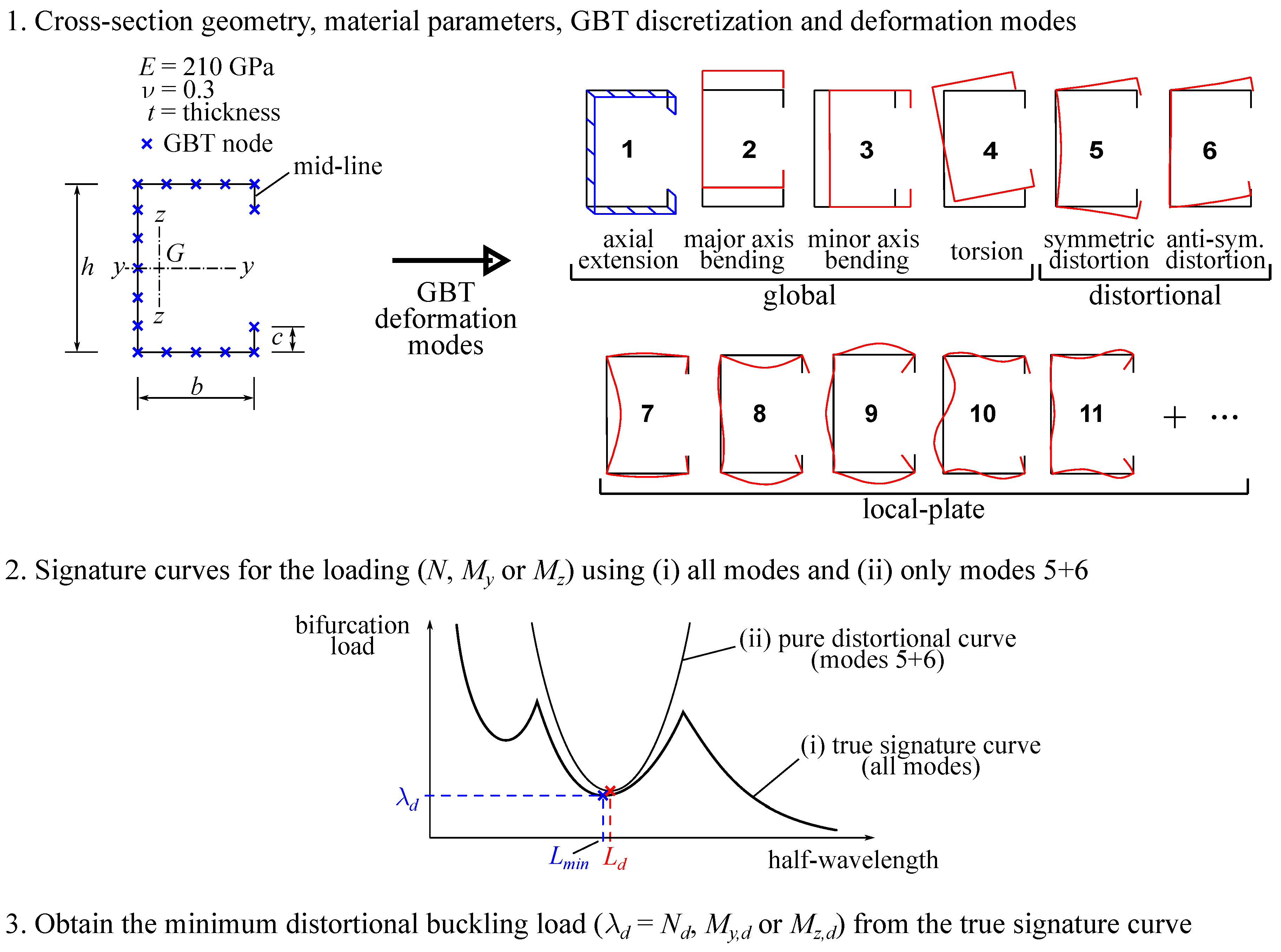
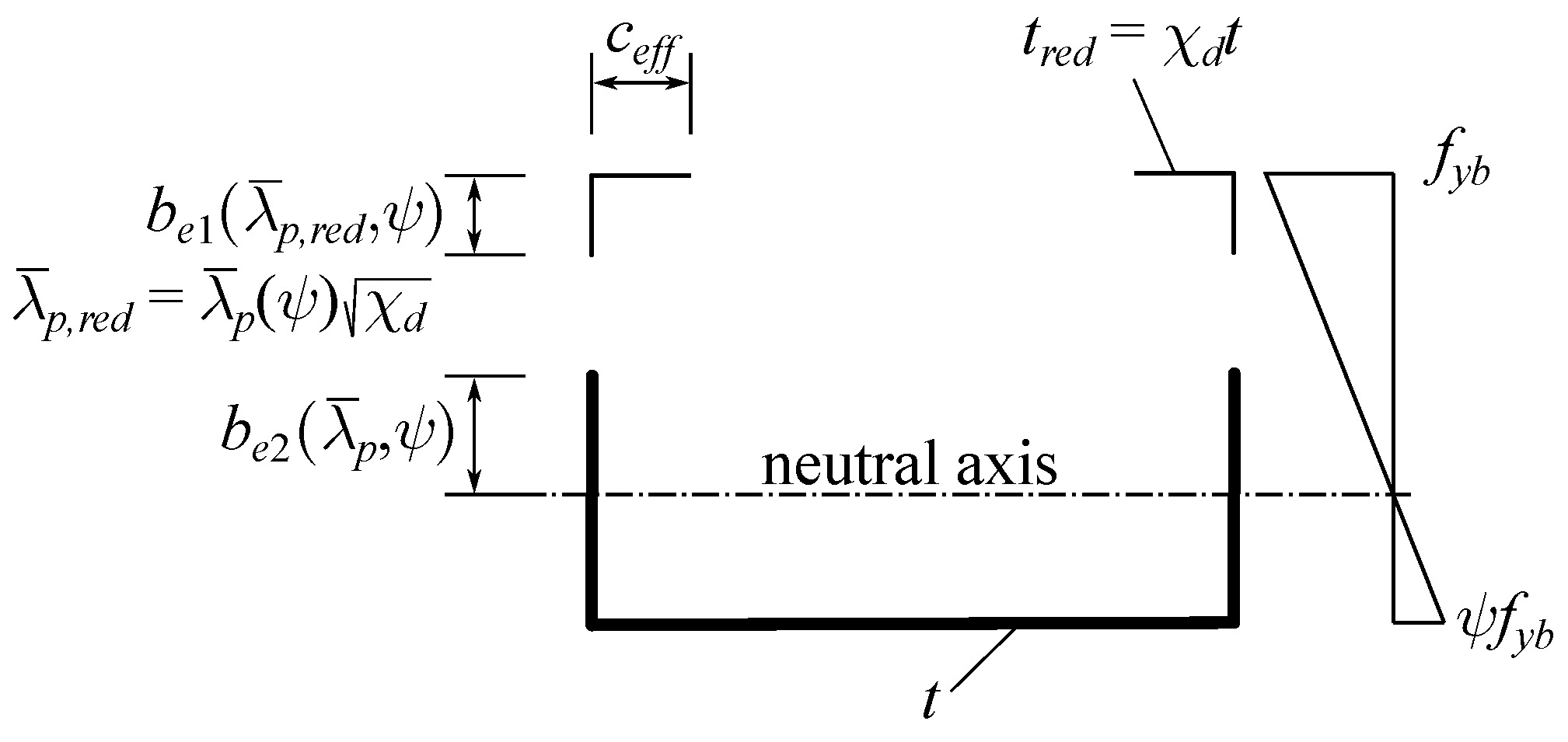

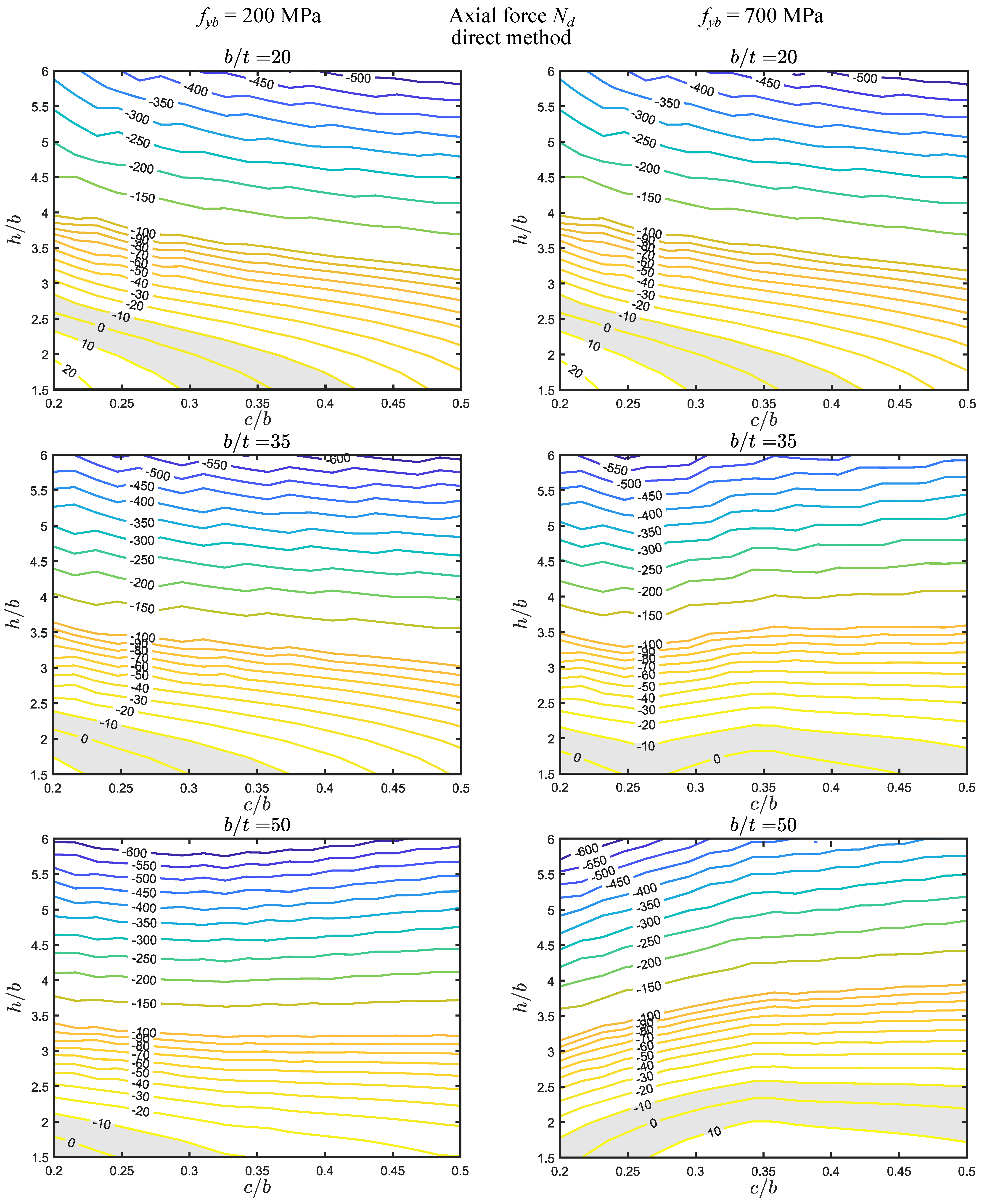

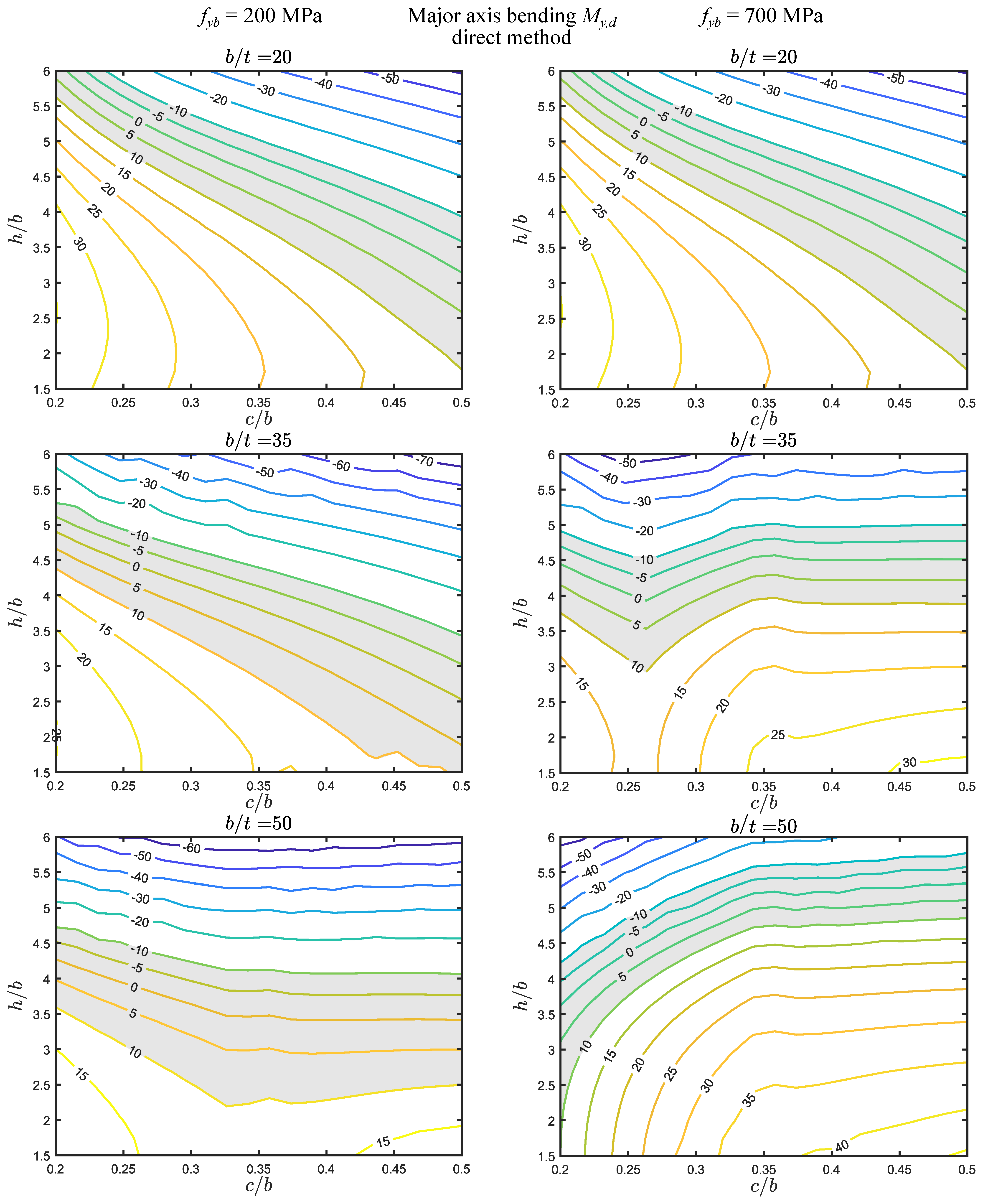


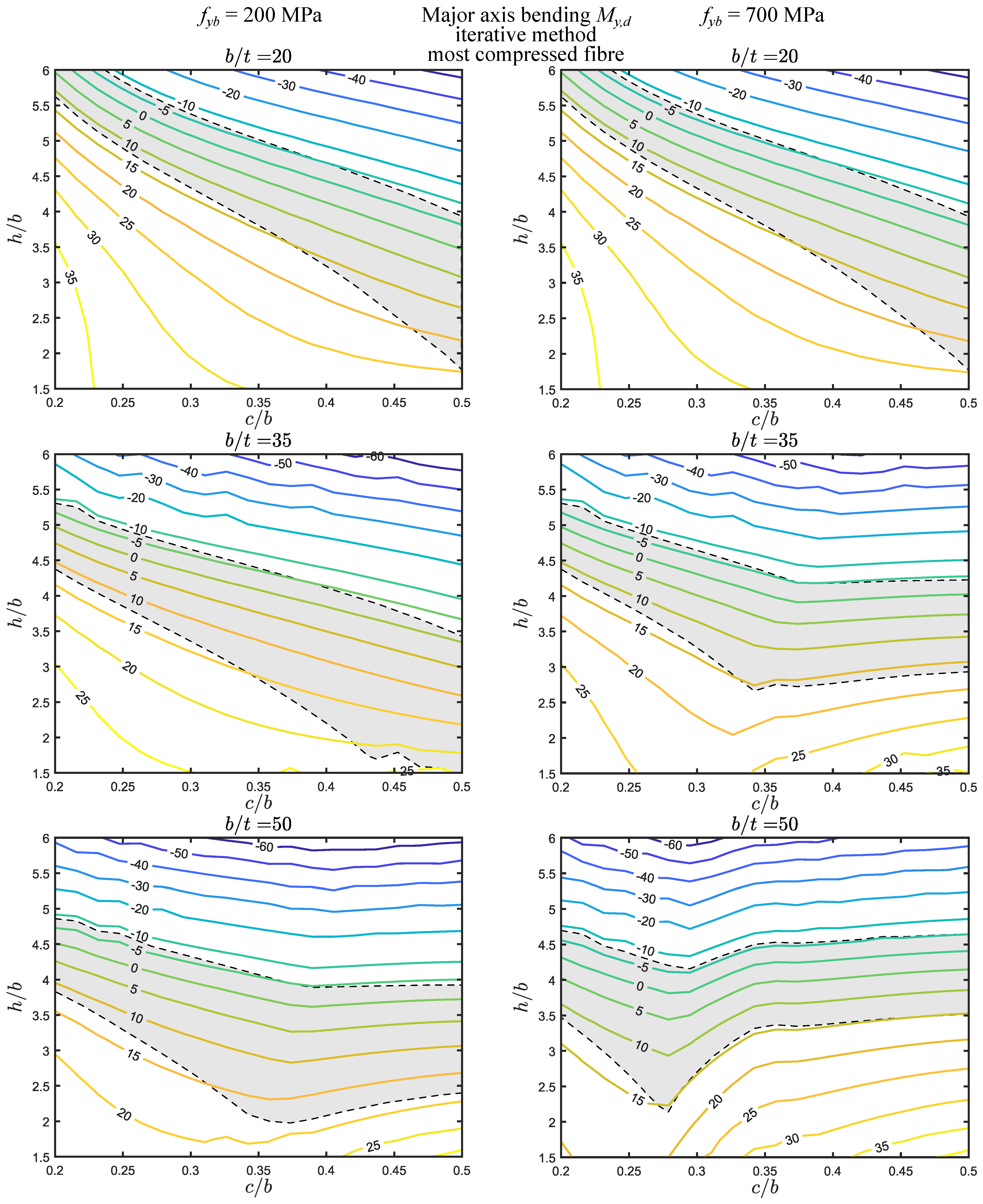
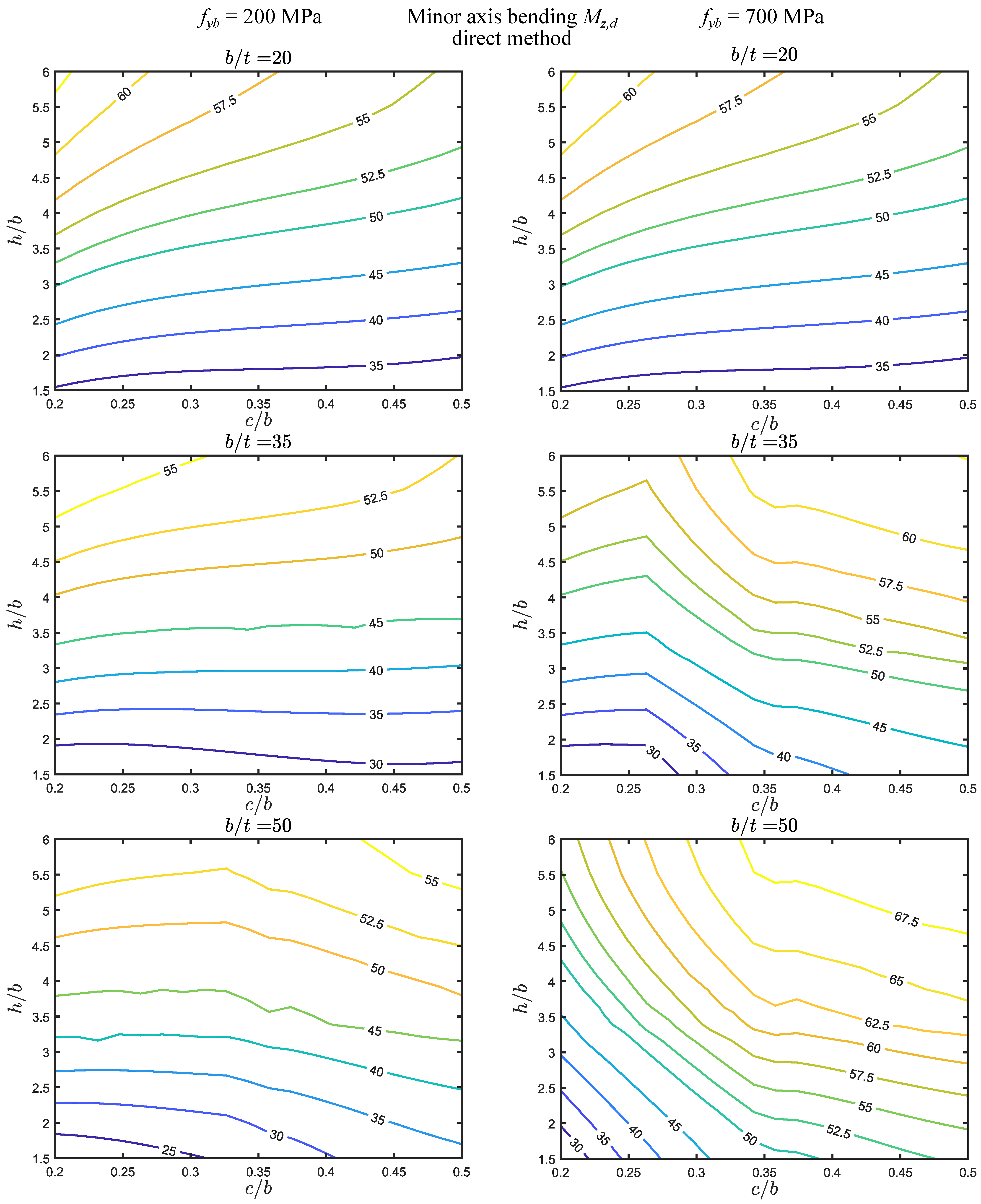
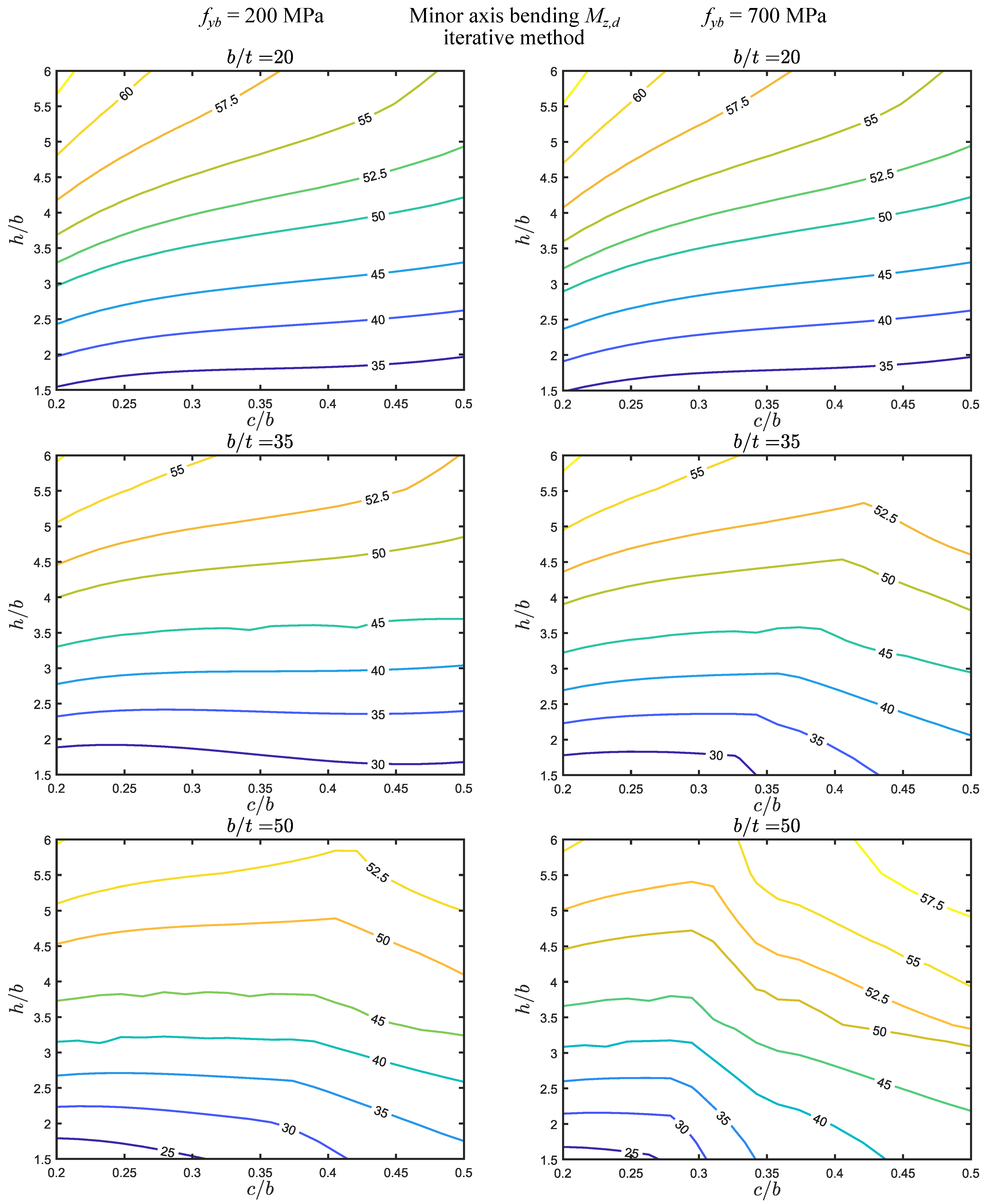
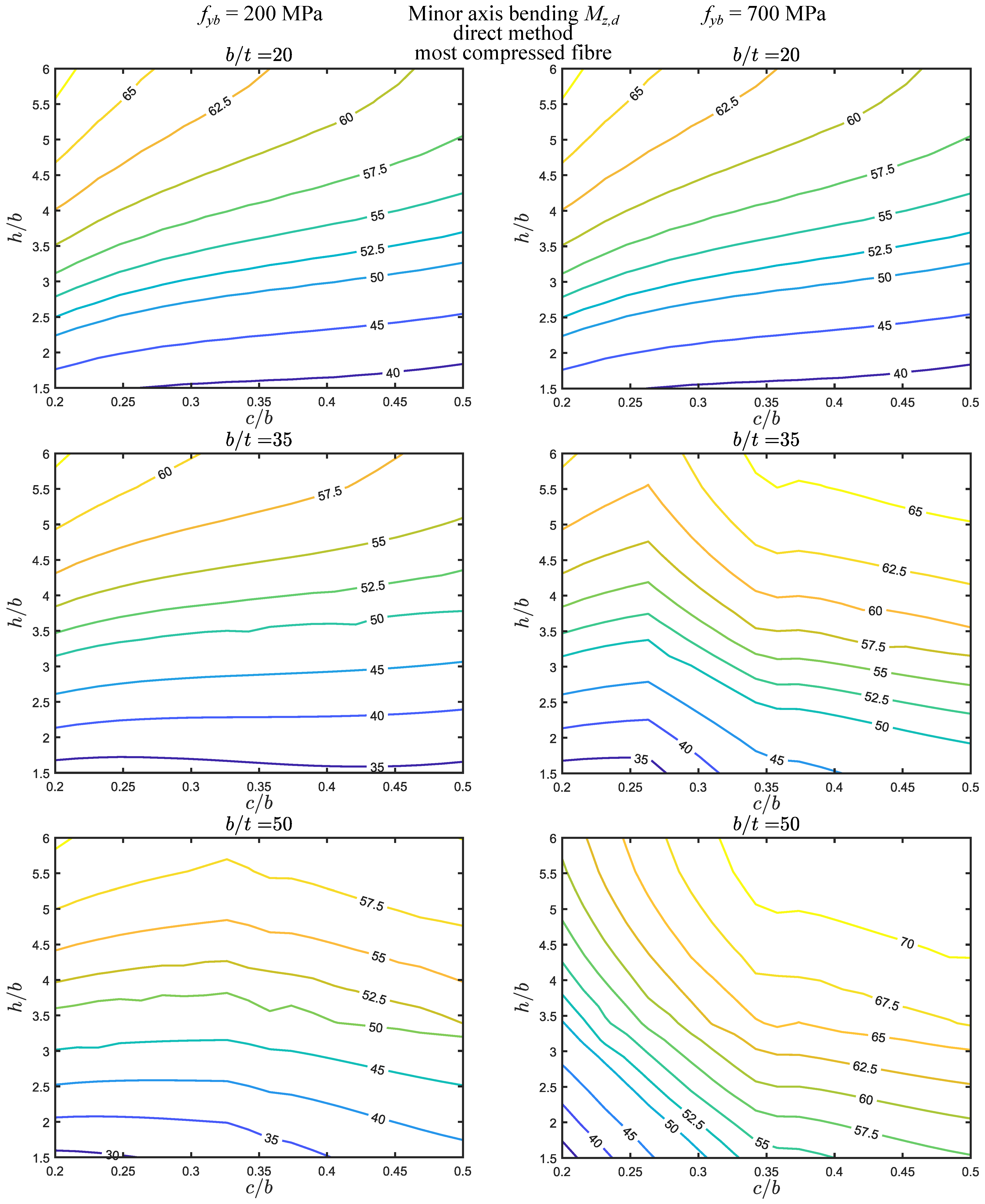

Disclaimer/Publisher’s Note: The statements, opinions and data contained in all publications are solely those of the individual author(s) and contributor(s) and not of MDPI and/or the editor(s). MDPI and/or the editor(s) disclaim responsibility for any injury to people or property resulting from any ideas, methods, instructions or products referred to in the content. |
© 2024 by the authors. Licensee MDPI, Basel, Switzerland. This article is an open access article distributed under the terms and conditions of the Creative Commons Attribution (CC BY) license (https://creativecommons.org/licenses/by/4.0/).
Share and Cite
Martins, A.D.; Peres, N.; Jacinto, P.; Gonçalves, R. An Assessment of the Eurocode 3 Simplified Formulas for Distortional Buckling of Cold-Formed Steel Lipped Channels. Appl. Sci. 2024, 14, 4924. https://doi.org/10.3390/app14114924
Martins AD, Peres N, Jacinto P, Gonçalves R. An Assessment of the Eurocode 3 Simplified Formulas for Distortional Buckling of Cold-Formed Steel Lipped Channels. Applied Sciences. 2024; 14(11):4924. https://doi.org/10.3390/app14114924
Chicago/Turabian StyleMartins, André Dias, Nuno Peres, Pedro Jacinto, and Rodrigo Gonçalves. 2024. "An Assessment of the Eurocode 3 Simplified Formulas for Distortional Buckling of Cold-Formed Steel Lipped Channels" Applied Sciences 14, no. 11: 4924. https://doi.org/10.3390/app14114924
APA StyleMartins, A. D., Peres, N., Jacinto, P., & Gonçalves, R. (2024). An Assessment of the Eurocode 3 Simplified Formulas for Distortional Buckling of Cold-Formed Steel Lipped Channels. Applied Sciences, 14(11), 4924. https://doi.org/10.3390/app14114924








